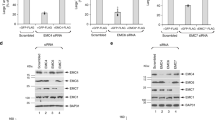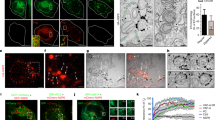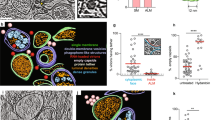Abstract
How non-enveloped viruses overcome host cell membranes is poorly understood. Here, we show that after endocytosis and transport to the endoplasmic reticulum (ER), but before crossing the ER membrane to the cytosol, incoming simian virus 40 particles are structurally remodelled leading to exposure of the amino-terminal sequence of the minor viral protein VP2. These hydrophobic sequences anchor the virus to membranes. A negatively charged residue, Glu 17, in the α-helical, membrane-embedded peptide is essential for infection, most likely by introducing an ‘irregularity’ recognized by the ER-associated degradation (ERAD) system for membrane proteins. Using a siRNA-mediated screen, the lumenal chaperone BiP and the ER-membrane protein BAP31 (both involved in ERAD) were identified as being essential for infection. They co-localized with the virus in discrete foci and promoted its ER-to-cytosol dislocation. Virus-like particles devoid of VP2 failed to cross the membrane. The results demonstrated that ERAD-factors assist virus transport across the ER membrane.
This is a preview of subscription content, access via your institution
Access options
Subscribe to this journal
Receive 12 print issues and online access
$209.00 per year
only $17.42 per issue
Buy this article
- Purchase on Springer Link
- Instant access to full article PDF
Prices may be subject to local taxes which are calculated during checkout








Similar content being viewed by others
References
Jiang, M., Abend, J. R., Johnson, S. F. & Imperiale, M. J. The role of polyomaviruses in human disease. Virology 384, 266–273 (2009).
Major, E. O. Progressive multifocal leukoencephalopathy in patients on immunomodulatory therapies. Annu. Rev. Med. 61, 35–47 (2010).
Eash, S., Manley, K., Gasparovic, M., Querbes, W. & Atwood, W. J. The human polyomaviruses. Cell Mol. Life Sci. 63, 865–876 (2006).
Liddington, R. C. et al. Structure of simian virus 40 at 3.8-A resolution. Nature 354, 278–284 (1991).
Stehle, T., Gamblin, S. J., Yan, Y. & Harrison, S. C. The structure of simian virus 40 refined at 3.1 A resolution. Structure 4, 165–182 (1996).
Schelhaas, M. et al. Simian Virus 40 depends on ER protein folding and quality control factors for entry into host cells. Cell 131, 516–529 (2007).
Daniels, R., Rusan, N. M., Wadsworth, P. & Hebert, D. N. SV40 VP2 and VP3 insertion into ER membranes is controlled by the capsid protein VP1: implications for DNA translocation out of the ER. Mol. Cell 24, 955–66 (2006).
Streuli, C. H. & Griffin, B. E. Myristic acid is coupled to a structural protein of polyoma virus and SV40. Nature 326, 619–622 (1987).
Varshavsky, A. J. et al. Compact form of SV40 viral minichromosome is resistant to nuclease: possible implications for chromatin structure. Nucleic Acids Res. 4, 3303–3325 (1977).
Tsai, B. et al. Gangliosides are receptors for murine polyoma virus and SV40. EMBO J. 22, 4346–4355 (2003).
Kartenbeck, J., Stukenbrok, H. & Helenius, A. Endocytosis of simian virus 40 into the endoplasmic reticulum. J. Cell Biol. 109, 2721–2729 (1989).
Ewers, H. et al. GM1 structure determines SV40-induced membrane invagination and infection. Nat. Cell Biol. 12, 11–18 (2010).
Neu, U., Stehle, T. & Atwood, W. J. The polyomaviridae: contributions of virus structure to our understanding of virus receptors and infectious entry. Virology 384, 389–399 (2009).
Engel, S. et al. Role of endosomes in simian virus 40 entry and infection. J. Virol. 85, 4198–4211 (2011).
Nakanishi, A., Clever, J., Yamada, M., Li, P. P. & Kasamatsu, H. Association with capsid proteins promotes nuclear targeting of simian virus 40 DNA. Proc. Natl Acad. Sci. USA 93, 96–100 (1996).
Nakanishi, A., Shum, D., Morioka, H., Otsuka, E. & Kasamatsu, H. Interaction of the Vp3 nuclear localization signal with the importin α2/β heterodimer directs nuclear entry of infecting simian virus 40. J. Virol. 76, 9368–9377 (2002).
Tsai, B. & Qian, M. Cellular entry of polyomaviruses. Curr. Top. Microbiol. Immunol. 343, 177–194 (2010).
Ploegh, H. L. A lipid-based model for the creation of an escape hatch from the endoplasmic reticulum. Nature 448, 435–438 (2007).
Vembar, S. S. & Brodsky, J. L. One step at a time: endoplasmic reticulum-associated degradation. Nat. Rev. Mol. Cell Biol. 9, 944–957 (2008).
Hegde, R. S. & Ploegh, H. L. Quality and quantity control at the endoplasmic reticulum. Curr. Opin. Cell Biol. 22, 437–446 (2010).
Hirsch, C., Gauss, R., Horn, S. C., Neuber, O. & Sommer, T. The ubiquitylation machinery of the endoplasmic reticulum. Nature 458, 453–460 (2009).
Carvalho, P., Goder, V. & Rapoport, T. A. Distinct ubiquitin-ligase complexes define convergent pathways for the degradation of ER proteins. Cell 126, 361–373 (2006).
Xie, W. & Ng, D. T. ERAD substrate recognition in budding yeast. Semin. CellDev. Biol. 21, 533–539 (2010).
Tsai, B., Rodighiero, C., Lencer, W. I. & Rapoport, T. A. Protein disulfide isomerase acts as a redox-dependent chaperone to unfold cholera toxin. Cell 104, 937–948 (2001).
Magnuson, B. et al. ERp29 triggers a conformational change in polyomavirus to stimulate membrane binding. Mol. Cell 20, 289–300 (2005).
Chen, X. S., Stehle, T. & Harrison, S. C. Interaction of polyomavirus internal protein VP2 with the major capsid protein VP1 and implications for participation of VP2 in viral entry. EMBO J. 17, 3233–3240 (1998).
Bonifacino, J. S., Cosson, P., Shah, N. & Klausner, R. D. Role of potentially charged transmembrane residues in targeting proteins for retention and degradation within the endoplasmic reticulum. EMBO J. 10, 2783–2793 (1991).
Ray-Sinha, A., Cross, B. C., Mironov, A., Wiertz, E. & High, S. Endoplasmic reticulum-associated degradation of a degron-containing polytopic membrane protein. Mol. Membr. Biol. 26, 448–464 (2009).
Keppler, A. et al. A general method for the covalent labeling of fusion proteins with small molecules in vivo. Nat. Biotechnol. 21, 86–89 (2003).
Shibata, Y. et al. Mechanisms determining the morphology of the peripheral ER. Cell 143, 774–788 (2010).
Schamel, W. W. et al. A high-molecular-weight complex of membrane proteins BAP29/BAP31 is involved in the retention of membrane-bound IgD in the endoplasmic reticulum. Proc. Natl Acad. Sci. USA 100, 9861–9866 (2003).
Wang, B. et al. BAP31 interacts with Sec61 translocons and promotes retrotranslocation of CFTRΔF508 via the derlin-1 complex. Cell 133, 1080–1092 (2008).
Wakana, Y. et al. Bap31 is an itinerant protein that moves between the peripheral endoplasmic reticulum (ER) and a juxtanuclear compartment related to ER-associated degradation. Mol. Biol. Cell 19, 1825–1836 (2008).
Lilley, B. N. & Ploegh, H. L. A membrane protein required for dislocation of misfolded proteins from the ER. Nature 429, 834–840 (2004).
Ye, Y., Shibata, Y., Yun, C., Ron, D. & Rapoport, T. A. A membrane protein complex mediates retro-translocation from the ER lumen into the cytosol. Nature 429, 841–847 (2004).
Younger, J. M. et al. Sequential quality-control checkpoints triage misfolded cystic fibrosis transmembrane conductance regulator. Cell 126, 571–582 (2006).
Kikkert, M. et al. Human HRD1 is an E3 ubiquitin ligase involved in degradation of proteins from the endoplasmic reticulum. J. Biol. Chem. 279, 3525–3534 (2004).
Bernasconi, R., Galli, C., Calanca, V., Nakajima, T. & Molinari, M. Stringent requirement for HRD1, SEL1L, and OS-9/XTP3-B for disposal of ERAD-LS substrates. J. Cell Biol. 188, 223–235 (2010).
Okuda-Shimizu, Y. & Hendershot, L. M. Characterization of an ERAD pathway for nonglycosylated BiP substrates, which require Herp. Mol. Cell 28, 544–554 (2007).
Oda, Y., Hosokawa, N., Wada, I. & Nagata, K. EDEM as an acceptor of terminally misfolded glycoproteins released from calnexin. Science 299, 1394–1397 (2003).
Molinari, M., Calanca, V., Galli, C., Lucca, P. & Paganetti, P. Role of EDEM in the release of misfolded glycoproteins from the calnexin cycle. Science 299, 1397–1400 (2003).
Ye, Y., Meyer, H. H. & Rapoport, T. A. The AAA ATPase Cdc48/p97 and its partners transport proteins from the ER into the cytosol. Nature 414, 652–656 (2001).
Ye, Y., Meyer, H. H. & Rapoport, T. A. Function of the p97-Ufd1-Npl4complex in retrotranslocation from the ER to the cytosol: dual recognition of nonubiquitinated polypeptide segments and polyubiquitin chains. J. Cell Biol. 162, 71–84 (2003).
Carlson, E. J., Pitonzo, D & Skach, W. R. p97 functions as an auxiliary factor to facilitate TM domain extraction during CFTR ER-associated degradation. EMBO J. 25, 4557–4566 (2006).
Nowis, D., McConnell, E. & Wojcik, C. Destabilization of the VCP-Ufd1-Npl4 complex is associated with decreased levels of ERAD substrates. Exp. Cell Res. 312, 2921–2932 (2006).
Ng, F. W. et al. p28 Bap31, a Bcl-2/Bcl-XL- and procaspase-8-associated protein in the endoplasmic reticulum. J. Cell Biol. 139, 327–338 (1997).
Breckenridge, D. G., Nguyen, M., Kuppig, S., Reth, M. & Shore, G. C. The procaspase-8 isoform, procaspase-8L, recruited to the BAP31 complex at the endoplasmic reticulum. Proc. Natl Acad. Sci. USA 99, 4331–4336 (2002).
Romisch, K. Endoplasmic reticulum-associated degradation. Annu. Rev. CellDev. Biol. 21, 435–456 (2005).
Nishikawa, S. I., Fewell, S. W., Kato, Y., Brodsky, J. L. & Endo, T. Molecular chaperones in the yeast endoplasmic reticulum maintain the solubility of proteins for retrotranslocation and degradation. J. Cell Biol. 153, 1061–1070 (2001).
Blond-Elguindi, S. et al. Affinity panning of a library of peptides displayed on bacteriophages reveals the binding specificity of BiP. Cell 75, 717–728 (1993).
Bernardi, K. M., Forster, M. L., Lencer, W. I. & Tsai, B. Derlin-1 facilitates the retro-translocation of cholera toxin. Mol. Biol. Cell 19, 877–884 (2008).
Richards, A. A., Stang, E., Pepperkok, R. & Parton, R. G. Inhibitors of COP-mediated transport and cholera toxin action inhibit simian virus 40 infection. Mol. Biol. Cell 13, 1750–1764 (2002).
Kamhi-Nesher, S. et al. A novel quality control compartment derived from the endoplasmic reticulum. Mol. Biol. Cell 12, 1711–1723 (2001).
Norkin, L. C., Anderson, H. A., Wolfrom, S. A. & Oppenheim, A. Caveolar endocytosis of simian virus 40 is followed by brefeldin A-sensitive transport to the endoplasmic reticulum, where the virus disassembles. J. Virol. 76, 5156–5166 (2002).
Engelman, D. M. Electrostatic fasteners hold the T cell receptor-CD3 complex together. Mol. Cell 11, 5–6 (2003).
Gilbert, J., Ou, W., Silver, J & Benjamin, T. Downregulation of protein disulfide isomerase inhibits infection by the mouse polyomavirus. J. Virol. 80, 10868–10870 (2006).
Lilley, B. N., Gilbert, J. M., Ploegh, H.L. & Benjamin, T. L. Murine polyomavirus requires the endoplasmic reticulum protein Derlin-2 to initiate infection. J. Virol. 80, 8739–8744 (2006).
Pelkmans, L., Kartenbeck, J. & Helenius, A. Caveolar endocytosis of simian virus 40 reveals a new two-step vesicular-transport pathway to the ER. Nat. Cell Biol. 3, 473–483 (2001).
Ishii, N., Nakanishi, A., Yamada, M., Macalalad, M. H. & Kasamatsu, H. Functional complementation of nuclear targeting-defective mutants of simian virus 40 structural proteins. J. Virol. 68, 8209–8216 (1994).
Walter, P. & Blobel, G. Preparation of microsomal membranes for cotranslational protein translocation. Methods Enzymol. 96, 84–93 (1983).
Acknowledgements
We thank H. Ploegh, G. Shore, E. Wiertz, H. Meyer, H. Kasamatsu, A. Oppenheim, L. Hendershot and K. Johnsson for sharing reagents. We are grateful to A. Smith, P. Deprez, J. Kartenbeck and R. Mancini for preparing mPy and microsomes and for help with electron microscopy. We thank D. Roderer for help with circular dichroism spectroscopy measurements. We thank members of the Helenius group for discussions, especially M. Schelhaas. This work was supported by the National Science Foundation of Switzerland, the LipidX programme of SystemsX, the European research council (ERC) and ETH Zurich.
Author information
Authors and Affiliations
Contributions
R.G. designed and carried out experiments and analysed the data. D.A., S.F., F.H. and S.L. carried out experiments. T.H. wrote the MATLAB program. R.G. and A.H. wrote the manuscript. A.H. supervised the work.
Corresponding author
Ethics declarations
Competing interests
The authors declare no competing financial interests.
Supplementary information
Supplementary Information
Supplementary Information (PDF 1783 kb)
Supplementary Table 1
Supplementary Information (XLS 100 kb)
Supplementary Table 2
Supplementary Information (XLSX 38 kb)
Supplementary Table 3
Supplementary Information (XLS 30 kb)
Rights and permissions
About this article
Cite this article
Geiger, R., Andritschke, D., Friebe, S. et al. BAP31 and BiP are essential for dislocation of SV40 from the endoplasmic reticulum to the cytosol. Nat Cell Biol 13, 1305–1314 (2011). https://doi.org/10.1038/ncb2339
Received:
Accepted:
Published:
Issue Date:
DOI: https://doi.org/10.1038/ncb2339
This article is cited by
-
Biological roles of the B cell receptor-associated protein 31: Functional Implication in Cancer
Molecular Biology Reports (2021)
-
Further delineation of BCAP31-linked intellectual disability: description of 17 new families with LoF and missense variants
European Journal of Human Genetics (2021)
-
BAP31, a newly defined cancer/testis antigen, regulates proliferation, migration, and invasion to promote cervical cancer progression
Cell Death & Disease (2018)
-
Exploiting the kinesin-1 molecular motor to generate a virus membrane penetration site
Nature Communications (2017)
-
Opportunistic intruders: how viruses orchestrate ER functions to infect cells
Nature Reviews Microbiology (2016)



